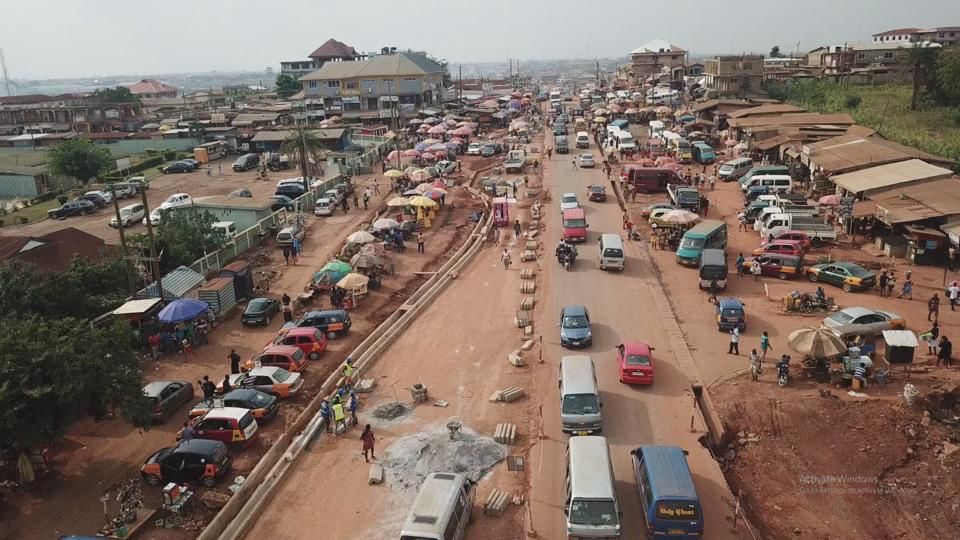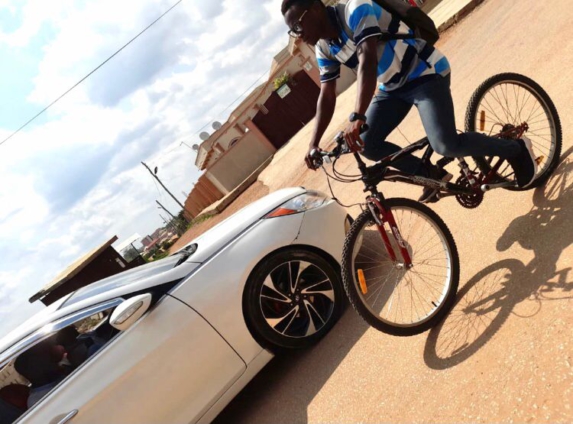It was a bright morn to usher Ghana into a new age of an environmentally-friendly means of transportation as the country forged ahead to mitigate the already exacerbating impacts of climate change.
Radiating as the morning sun, the happy, smiling faces of individuals who graced the launch of the Ghana Bamboo Bikes Initiative’s EcoRide were evidence that the country was making a paradigm shift in its transportation sector.
The occasion unveiled zero carbon emitting bicycles onto Ghana’s roads, aimed at fostering environmental sustainability and conserving biodiversity.
Among the dignitaries that took turns on the podium for ‘green’ transformation was former President of Ghana, John Agyekum Kufuor. In his remarks as the guest speaker and United Nation’s Special Envoy for Climate Change, he advocated the enactment of laws to promote cycling in Ghana.

“Create an environment where those who prefer to use these bicycles can ride them safely everywhere. Such by-laws will help promote the use of bicycles in our communities and also encourage those who sit in the comfort of four-wheel drives to exercise their muscles,” said Mr. Kufuor, according to Graphic Online.
However, the audacious call from the onetime Commander-in-chief of the Ghana Armed Forces could not garner enough audience from the government as resounding and bold as the ‘atumpan’ pair of talking drums which deafened the ears of its listeners at the event.
The promising social enterprise, fully dedicated to cleaner transportation, was to be a momentous leap from the thick plume of smoke gushing out of the exhaust pipes of most motor vehicles on the roads to clearer and refreshing air.
Since the unveiling of the bamboo bikes in 2016, the transport division continues to sit atop the league of greenhouse gas emitters in the Energy sector of the country.
Carbon dioxide emissions lurking in the atmosphere
Calculated levels of carbon dioxide emissions captured by the United Nations Climate Change report indicates that Ghana recorded a 16.0% increase from 50.47 MtCO2e in 2016 to 58.56 MtCO2e in 2019. The Energy sector is identified to contribute the most significant amount of the gas, pegged at 26.38 MtCO2e (~46%). Under this sector, the fleet of motorized vehicles on the roads is a major contributor, “egesting” 34% of the overall CO2 emissions followed by gas flaring (30%) and electricity generation (24%).
The government of Ghana in its Third Biennial Update Report to the United Nations Climate Change suggested 33 mitigation measures in an attempt to reduce its overall greenhouse gas emissions to 68.1MtCO2e by 2030. These measures were to be conducted across the Energy, Transport Industry, Oil and Gas, Industrial Processes and Products use (IPPU), Food and Land-use (FOLU), and Waste sectors.
In the transport sector specifically, efforts of shifting freight transport from road to rail, restricting the import of used cars, introducing more efficient diesel cars, and constructing bicycle lanes were adopted to collectively reduce 91.09 kt/year of emissions by 2030, with the latter slashing emissions in the sector by 60%.
Non-motorised transport which includes walking and cycling is said to be a non-polluting and largely sustainable form of transport. Aside from reducing urban noise and congestion, a 2021 study by the University Of Oxford, England reveals that cycling just a day reduces the average person’s carbon emissions from transportation by 67%.

The Intergovernmental Panel on Climate Change in 2021 affirmed bicycling as a solution to ensure a sustainable world for all. However, this reality may be far-fetched for Ghana as most road links in the cities lack properly defined bicycle lanes.
Whilst a few streets in Ghana’s urban centres like Accra boast of bike lanes, Kumasi, the second largest city, is lost in the woods.
Squeezing along the tiny road space
Along the shoulder of Kotei-Emena road in Kumasi, Timothy Gyan – a devout cyclist – innocently and briskly rides his bicycle through the busy stretch to work on a Monday morning rush hour. He travels close to 16 kilometers from his home in Anwomaso to Atonsu, both suburbs in the city, to teach his students.
He makes instantaneous stops whenever he notices that oncoming vehicles could knock him off the road into the open gutters lying only a few inches away from him.
“Instead of the drivers giving you a little space, they won’t. They want to be in their lane which we [the riders] sadly do not have. Even if you fall into the gutter, they don’t care. So, you the rider have to be smart to stop,” he says.
The situation gets precarious when heavy trucks speedily pass him by: “the strong mass of wind behind these vehicles can throw you into a nearby ditch if you don’t stop,” he added.
Timothy’s five-year experience on the road reflects the ordeal many bikers in the city and in other parts of the country endure. In most unlucky cases, bikers crash into vehicles, thus contributing to Ghana’s bike mortalities which presently stands at 0.8 per 100,000 people – according to the Global Road Safety Report. The non-standardized road in the cities which does not make provisions for all its users is attributable to the growing bike accidents.
A typical stretch of road in Kumasi has no adequate meters of a shoulder to accommodate bikers.
There are presently no designated bike lanes in the “Garden City”.
Bike Lanes nowhere to be found
None of the over 1,975.78km of roads stretching through the city of Kumasi has a shred of space dedicated solely for bicycle use.
According to Peter Sarfo, a sub-metro engineer at the Kumasi Department of Urban roads, demarcation for the construction of a 7.4km stretch of road within the Asokore Mampong and Asawase enclaves will have a lane on the stretch designated for cycling.
Portions of the Benson Factory road – Oduom to Aboabo Corridor – demarcated by city planners 45 years ago for the purpose have been encroached upon, leaving no more space for cycling lanes.
“We have reservations on that road. But there is a problem at the end. We have to demolish about 250 buildings and pay them off before we can continue. The way these encroachers build their homes is not uniform. We will have to clear everything before we can get the space,” Peter Sarfo said.
Presently, cyclists have to face head-on with pedestrians on the slender routes left along the roads. In some cases, the shoulder of the road has been illegally used as parking spaces for vehicles and the tremendous overspill of trade items into the road is affording bikers with no choice but to travel on the wrong side of their path.
In April 2022, the Vice President of Ghana, Dr. Mahamudu Bawumia, cut sod for works to begin on the Kumasi Inner City Roads with no priority given to cyclists.
The road was to be constructed in Suame, Kwadaso, Bantama, and Manhyia with the scope of works focusing on roadside drains, culverts, and road line markings. No demarcation was made for bicycle lanes on either of these roads.
Contrastingly, the lack of proper infrastructure for cyclists defeats the 2020 National Transport Policy of “creating an accessible, affordable, reliable, safe and secure transport for all users” spelled out by the Ministry of Transport.
The absence of these lanes and the influx of private motorized vehicles on the roads only affirm expectations of Ghana’s emissions to increase by 75% in 2030.
Green Active Transport, the Way Forward
“If we do not protect our biodiversity, we are threatening our future,” Ex-president John Agyekum Kufour, ending his speech at the unveiling, emphasised.
The admonition of the statesman came on the heels of the increasing threats to people’s existence and livelihoods stemming from Climate Change. Today, indigenes of communities along Ghana’s coast are migrating to seek shelter and have a fresh start elsewhere, as their lands deteriorate from the advancing sea levels.
The chains of sweat dripping down a farmer’s face under the current sweltering weather are gradually becoming his only source of irrigation for his farm. Proceeds from the vast lands are depreciating due to lower yields, stemming mainly from erratically reduced rainfall and increasing temperatures.
The changes in the environment and ecosystem are primarily due to the heavy emissions of greenhouse gases into the atmosphere.
To cut down these emissions, countries must religiously adopt measures to move away from motorized transport.
Cycling or walking to the office or market for groceries which is within a 5 km range is said to be a sustainable and active form of mobility with fewer carbon footprints. The 2021 study by the University Of Oxford, England revealed that people who already cycled had 84% lower CO2 emissions from all daily travel than non-cyclists.
Research emphasizes that cycling has a carbon footprint of about 33 grams of CO2 per mile traveled which is up to 30 times lower than fossil fuel cars or taking public transportation.
Business travel, followed by social and leisure trips, and commuting to work or a place of study were identified to be the largest benefits from the shift from car to active travel.
Head of the Transport Division of the Building and Road Research Institute (BRRI), Dr. Williams Ackaah, reiterated the need for the construction of lanes to encourage cycling.
He called for its inclusion on subsequent road projects and enforcement of existing laws to ward off encroachers.
“There is no evidence that people in Kumasi do not like cycling. We haven’t made provisions for bikers so we cannot conclude people are not interested in cycling. We need to encourage active transportation by making a conscious effort to demarcate lanes for cyclists,” he said.
He continued: “Traders can encroach on these lanes as we’ve seen with the pedestrian walkway. We must enforce the law in ensuring we maintain these lanes just in case they are built.”
Sarfo suggests introducing bicycle lanes in Kumasi may come at the cost of sensitizing people.
“If we want to build the lanes, then it means we have to educate more people in Kumasi. Because safety is also another thing,” he said.
The Bible and Qur’an explicitly teach their readers to superintend and protect the land given to them by its Creator.
Genesis 2:15 in the King James Version of the Bible reads: “And the LORD God took the man, and put him into the Garden of Eden to dress it and to keep it”.
The Holy Qur’an’s Surah Al-Araf, Verse 56 reads;
“وَلَا تُفْسِدُوا فِي الْأَرْضِ بَعْدَ إِصْلَاحِهَا وَادْعُوهُ خَوْفًا وَطَمَعًا إِنَّ رَحْمَتَ اللَّهِ قَرِيبٌ مِّنَ الْمُحْسِنِينَ “ to wit - “And do not make mischief in the earth after its reformation, and call on Him fearing and hoping; surely the mercy of Allah is nigh to those who do good (to others)”.
Posterity and its ecosystem are at risk of irreparable damage if the present humanity fails to safeguard the Earth.
Latest Stories
-
Grow For Me: Transforming Agriculture through mobile investment
51 minutes -
Musk’s Grok signs $200m deal with Pentagon days after antisemitism row
1 hour -
10 Chinese nationals denied bail in gold case
1 hour -
Work-and-pay driver remanded for car theft
1 hour -
Man arrested for allegedly stealing prepaid meters
2 hours -
South African car exports to U.S. plunge as Trump tariffs bite
2 hours -
Cameroon’s Biya, 92, brushes off health fears in bid for new term
2 hours -
Teddy bear made from fake human skin leads to California arrest
2 hours -
Beyoncé’s unreleased music stolen from car during Cowboy Carter tour
2 hours -
Nigeria’s former leader Buhari to be buried on Tuesday, official says
3 hours -
Local Government Ministry pays allowances to over 9000 assembly members
3 hours -
Telecel Ghana honoured with National Safety Award for Corporate Excellence
3 hours -
‘Adidome is not a town of ritual killers’ – Chief breaks silence, denounces allegations
3 hours -
Trump threatens Russia with tariffs while unveiling Ukraine weapons plan
3 hours -
Accra hosts Global Prayer Works Summit for the first time
4 hours

